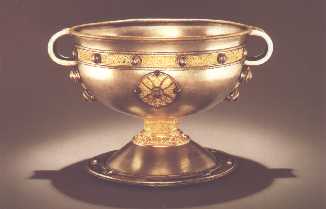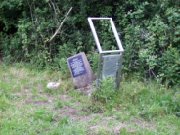| The Ardagh Chalice

The Ardagh Chalice
Photograph © National Museum of Ireland
The name of Ardagh is inextricably linked to the Ardagh Chalice. Ireland's
foremost treasure is currently housed in the National Museum of Ireland
and is considered the `Jewel in the Crown' of all exhibits there. The
beautifully proportioned Ardagh Chalice is the finest example of eighth
century metalwork ever to have come to light. Standing six inches high
it is made of silver, bronze and gold; the design and decoration indicating
technical proficiency of the highest order.
According to the book Treasures of Early Irish Art (Metropolitan Museum
of Art, New York: 1977):
"A wide range of materials have been used to create a work of perfection.
The silver bowl, provided with handles for lifting, is linked by a gilded
collar to a conical silver foot, made more stable by a broad horizontal
flange … on the chalice, where decoration is used, it is sumptuous.
Ultimate LaTene scrolls, plain interlace, plaits and frets abound. The
techniques employed are engraving, casting, filigree, cloisonné
and enamelling. Below the horizontal band of gold filigree on the bowl
the names of the Apostles in shining metal standout in sea of stippling."
It was discovered in September 1868 by two men digging potatoes in a
ring fort at Reerasta, Ardagh. They were Jimmy Quin and Paddy Flanagan.
It is unclear why they were digging potatoes in a fort, although it is
possible that they believed that the potatoes grown here would be safe
from the blight that had afflicted the potato crop during the Great Famine.
The Sisters of Mercy owned the land and Mrs. Quin rented about 15 - 20
acres from the nuns. Jimmy was her son and Mr Flanagan was a workman employed
at the time by the Quin family. It has been suggested that it was he who
actually found the chalice but that Quin took all the glory. He felt aggrieved
by the situation and felt obliged to leave the employment of the Quin's.
On his death he was buried in the Paupers' graveyard in Newcastlewest.
The other man, Quin, later emigrated to Australia where he died. Mrs
Quin sold the items to the Bishop of Limerick, Dr. Butler, at the time
for £50.00. Dr. Butler in turn sold the chalice to the Royal Irish
Academy for £500. The Ardagh chalice now resides at the National
Museum. The chalice itself was one of a number of objects found at the
time. There was also a smaller bronze chalice as well as four ornate brooches,
which collectively became known as the 'Ardagh Hoard'.

© Site of the discovery of the Ardagh Chalice
There is a note in "Treasures of Thomond" by Bishop Jeremiah
Newman, regarding the Ardagh chalice. Bishop Newman found an interesting
entry in the Earl of Dunraven's papers on the chalice. Mrs. Quin had about
twenty years previously to the 1868 discovery found a gold chalice fifty
yards west of the fort. This chalice was lost when "...One day her
children took it out of the house to play with and ... she never saw it
again."
One of the items found was a wooden cross, which came into the possession
of a Curate, Fr O'Connor. He kept the cross, which he thought to be relatively
valueless. Later he passed it on to a young man with whom he was very
close. This man died at a young age and his mother kept the cross. Begley
later came across this artefact in the mother's house. She explained the
story to him. According to Begley:
"The image of our saviour is carved on one side, and has an antique
appearance. On the other side the emblems of the Passion are cut by a
later and ruder artist, beneath which are the figures 727, evidently intended
for 1727, the date of the year"
Begley believes that this date helps to pinpoint the year of concealment
of the chalice. He believes that this year could have been around 1740
as at that time the penal laws were being rigorously enforced. Another
factor which would tend to point to the validity of this theory is the
fact that according to local tradition mass used to be said in the Rath
near the site of discovery during penal times.
The Ardagh Chalice itself is made from a silver-bronze alloy and its
main features include delicate gold filigree work, ornate handles and
the use of semi-precious and coloured stones and enamels. The overall
impression is that of a master craftsman at work and probably dates from
the eight century. The site at which it was discovered can still be pointed
out to visitors at Reerasta, Ardagh, in Co. Limerick. Only part of the
fort remains as the middle of the fort has been excavated.
There is nothing known of the history of this precious relic, or how
it came to be buried in the Rath. It is suggested that it is one of the
valuable cups that were stolen from Clonmacnois, in the year 1125, by
a Limerick Dane, who was captured and hanged the following year.
According to tradition, mass used to be said in the Rath where the discovery
was made, in the penal times. The chalice may have been used on these
occasions to distribute communion to the multitude that assembled there.
Perhaps when the alarm was raised to signify the approach of soldiers,
and in the hurry of the moment, the chalice was hidden to prevent it from
falling into the wrong hands. This would be supported by the condition
in which the items were found, with neither case nor covering to protect
them, suggesting that they were buried in a hurry. The person who placed
them in the earth (Begley hinted that it might have been a Fr Bermingham,
as he had to leave the area in a rush due to an alleged assault) may never
have had an opportunity of returning to the place to retrieve them.
 
|